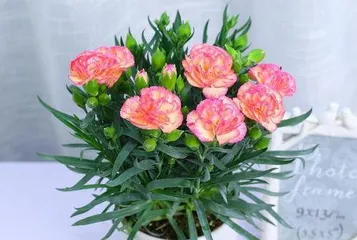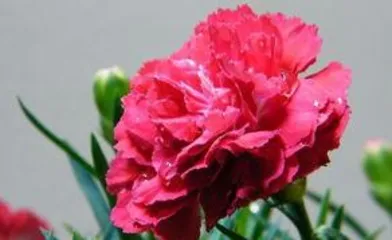I have a pot of carnations at home, and looking at the vibrant flowers, my mood brightens up! But did you know, to keep this "mother's flower" blooming beautifully, it takes some effort. Today, let me share some tips with you on how to care for carnations, making it a beautiful addition to your home!
Sunlight and Temperature, Carnation's "Sunshine Boy"
Carnations are real sunshine lovers; they thrive in plenty of light but are afraid of being scorched by strong sunlight. Therefore, when caring for them, you need to find a sunny spot, but don't forget to provide some shade in the summer. As for temperature, 19-21°C is ideal. In winter, you need to give it a "warm coat," and the temperature should be maintained above 9°C. In summer, make sure it doesn't exceed 35°C.
Soil and Water, Carnation's "Nutritionist"
Carnation roots are not very deep, so the soil should be loose, fertile, and well-draining. You can mix peat soil, river sand, and vermiculite in a 1:1:1 ratio. This type of soil is both breathable and nutrient-rich. As for watering, carnations like a moist environment, but they cannot tolerate waterlogging. Water thoroughly each time, but don't let the soil stay soggy. Generally, watering once every two days is sufficient during the vigorous growth period.
Fertilizing and Pruning, Carnation's "Beautician"
Carnations need appropriate fertilization during their growth period; you can apply a light fertilizer every 7-10 days. As for pruning, dead flowers should be cut off promptly to encourage continuous blooming. Additionally, if you find withered, yellowed branches or diseased spots, they should also be removed in time to prevent them from affecting the growth of other healthy branches and leaves.
Pest and Disease Control, Carnation's "Doctor"Carnations might encounter some pests and diseases, such as leaf spot, aphids, and spider mites. When this happens, you need to take timely measures. For example, if you find leaf spot, you can spray with mancozeb or chlorothalonil. If there are many aphids and spider mites, you can pick off the diseased leaves and spray with omethoate solution.
Waking Flowers and Arranging, Carnation's "Artist"If you plan to put carnations in a vase, remember to "wake them up" before arranging. The specific method is: cut the roots of the carnations at a 45-degree angle, then place them in a bucket full of water and soak for about 3 hours. After waking them up, arrange the leaves and remove any excess leaves. Next, you can start arranging. Note that the water in the vase should not be too high, just 3-5 centimeters or up to the first joint of the flower stem. Trim the roots according to the height of the vase, avoiding the nodes, and place the carnations in the vase. A beautiful bouquet is ready!
Caring for carnations is not actually difficult. As long as you take good care of them with love, they will surely bring you endless beauty and joy. Come and try it, and let your home be even more warm and cozy because of the carnations!